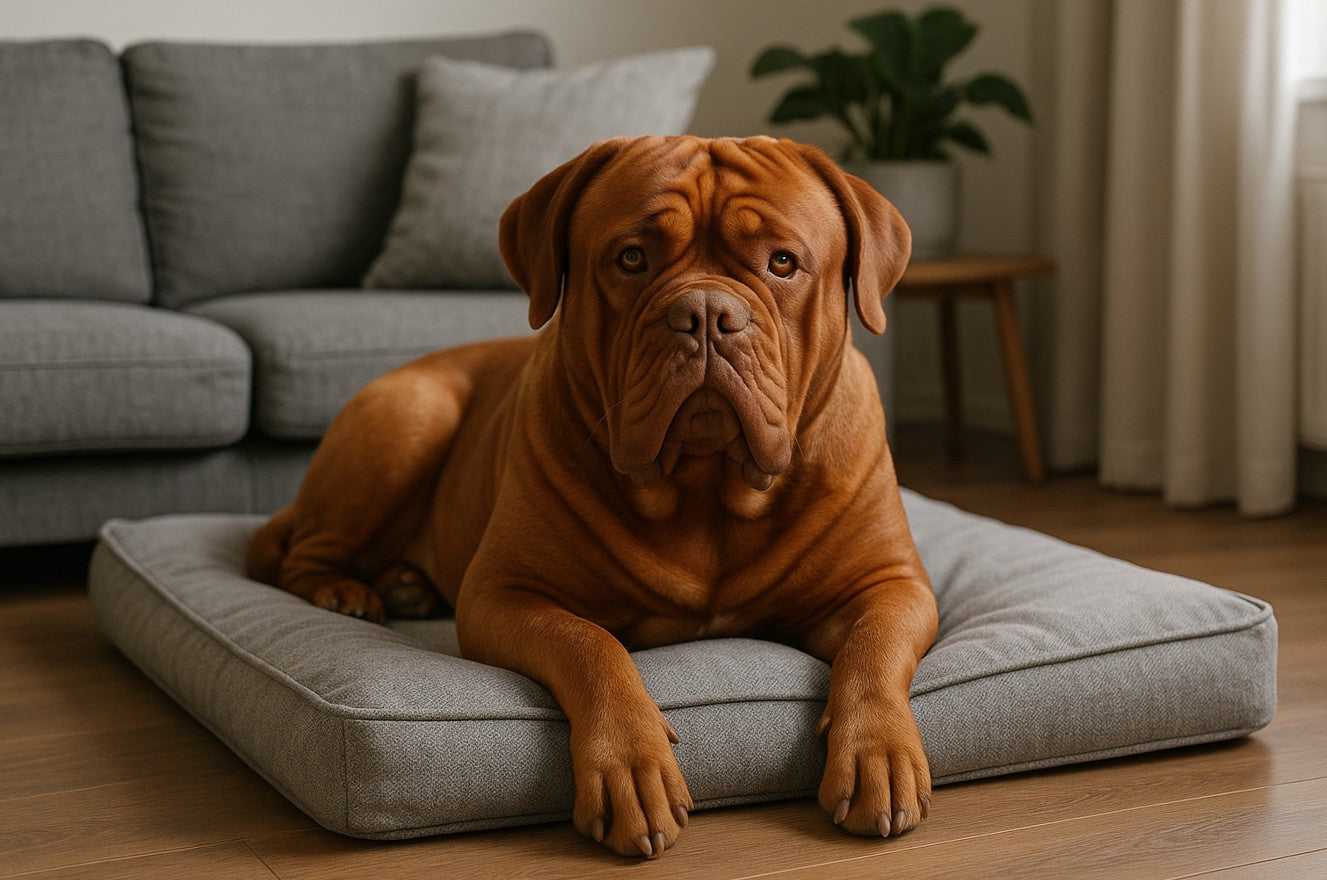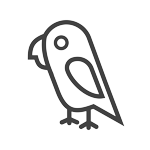
Dogue de Bordeaux: The Ultimate Guide to This Gentle Giant
If you’ve ever locked eyes with a Dogue de Bordeaux, you’ll know—it’s hard to forget. With their massive heads, soulful eyes, and that signature droopy jowl, these dogs are a walking paradox: intimidating yet endearing, powerful yet affectionate.
Also known as the French Mastiff, the Dogue de Bordeaux has a rich history and a heart even bigger than its hefty frame. Whether you’re thinking of welcoming one into your home or you’re already knee-deep in slobbery kisses and snoring nights, this guide is here to give you the real deal on life with this gentle giant.
Now, don’t let their tough exterior fool you. These dogs are all about loyalty, snuggles, and protecting their people. But they’re not a walk in the park either (figuratively speaking—they do love a good literal walk). They’ve got specific needs, health considerations, and a temperament that demands thoughtful training and care.
In this deep dive, we’ll unpack everything you need to know about Dogue de Bordeaux dogs—from their history and appearance, to their temperament, diet, health, and more. If you’re after a companion that’s equal parts slobber and soul, you might just find your match here.
A Brief History of the Dogue de Bordeaux
From Ancient Warriors to French Nobility
The Dogue de Bordeaux is one of the oldest French dog breeds, with roots that trace back thousands of years. Some experts believe their ancestors were used by the Romans in battle, while others point to ancient Molosser dogs brought to Europe by trading caravans and military campaigns. Either way, one thing’s clear: these dogs were bred for power.
By the Middle Ages, the Dogue de Bordeaux had found its place in French society—not as a lapdog, but as a working dog used to guard castles, pull carts, and hunt boar. Their strength and fearlessness made them invaluable to butchers and farmers who needed a reliable dog to guard property and livestock.
Survival Through Revolution and War
The breed’s history hasn’t been smooth sailing. During the French Revolution, when symbols of the aristocracy were targeted, many Dogues were wiped out due to their close association with nobility. Then came the World Wars, which saw their numbers dwindle even further. It wasn’t until the mid-20th century that serious efforts to revive and preserve the breed began, particularly through the work of French breeders who developed a breed standard to stabilise its appearance and health.
Today’s Dogue de Bordeaux
These days, the Dogue de Bordeaux is better known as a loyal family protector than a war dog. They gained international fame thanks to the 1989 movie Turner & Hooch, where Tom Hanks starred opposite a slobbery Bordeaux with a whole lot of personality. Since then, their popularity has grown steadily—but they remain a relatively rare breed outside of Europe, especially in Australia.
Their history may be storied with strength and grit, but modern Dogue de Bordeaux dogs are softies at heart. That mix of fierce loyalty and goofy affection is exactly what makes them so lovable.
Appearance – Big, Bold, and Wrinkl

Size & Build: The Definition of a Gentle Giant
The Dogue de Bordeaux is a massive, muscular breed that commands attention the moment it enters a room—or, more likely, sprawls across your entire lounge. Males typically weigh between 60–68 kg, while females range from 45–50 kg. And with a height of around 58–68 cm at the shoulder, you’ll want to clear some floor space (and maybe reinforce the sofa).
Their build is solid, with a broad chest, thick neck, and powerful limbs. But despite the intimidating size, there’s a surprising grace to how they move—more lumbering teddy bear than clumsy brute.
That Iconic Face: Wrinkles and Jowls for Days
One look at a Dogue de Bordeaux’s face and you’ll understand why they’re such a hit on social media. Their massive, wrinkled heads are one of the largest among all dog breeds, and their trademark droopy jowls give them a perpetually concerned (yet endearing) expression. Add in a short, wide snout and a slight underbite, and you’ve got a face that’s equal parts noble and silly.
Their eyes are usually hazel or dark brown, giving them a soulful, thoughtful look that contrasts beautifully with their brutish physique.
Coat Colours & Natural Markings
The Dogue de Bordeaux has a short, fine coat that lies close to the skin. The standard colour is fawn, which can vary from a light beige to a deep mahogany. Some have a black or brown mask around the muzzle, while others are maskless with a uniform coat.
You might notice small white patches on the chest and toes—these are allowed in the breed standard and often add a charming splash of contrast. Their coat is naturally low-maintenance, which is great, considering everything else about them is… not.
Dogue de Bordeaux Temperament – A Gentle Giant’s Soul
Naturally Protective, Deeply Loyal
The Dogue de Bordeaux may look like a bouncer at a nightclub, but inside? They’re a total softie—at least with the people they love. These dogs are incredibly loyal, often forming strong attachments to their family. Their natural instinct is to protect, which makes them excellent watchdogs without the need for constant barking or aggression.
You don’t train a Bordeaux to be protective—it’s already in their blood. But their calm, balanced demeanour means they’re not the type to react unless there’s a real reason.
Affectionate Homebodies
Don’t expect high-energy chaos. Dogue de Bordeaux dogs are naturally laid-back and thrive on lounging with their people. They’re the kind of dog that’ll follow you from room to room, flop down at your feet, and snore like a freight train.
They’re affectionate but not clingy. They value companionship, and many Bordeaux owners say their dogs are “in tune” with their emotions—often offering a giant paw or nuzzle when you need it most.
Good with Kids and Other Pets—If Raised Right
A well-socialised Dogue de Bordeaux can be wonderful with children. Their natural patience and calm energy make them excellent family companions. That said, their sheer size means supervision is essential, especially around young kids—they’re more likely to knock someone over with their bum than bite!
With other pets, it depends heavily on how they’re raised. Early socialisation is key. While they can live peacefully with other dogs (especially if introduced young), their guarding instincts may kick in if they feel another animal is a threat.
Are They Aggressive?
Despite their intimidating appearance, aggression isn’t typical of the breed. Poor training, lack of socialisation, or irresponsible ownership is usually to blame when behavioural issues occur. When raised with consistency and kindness, they’re natural guardians—not bullies.
Puppy Stage – Raising a Dogue de Bordeaux Puppy

Big Paws, Bigger Responsibility
Bringing home a Dogue de Bordeaux puppy is a bit like adopting a baby rhino. They’re clumsy, curious, and completely unaware of their size. At just a few months old, they’re already heavier than many small dogs—and they’re only getting started.
It’s absolutely critical to start training and socialising from day one. These dogs grow fast, and what seems cute at 10 weeks (like jumping up or nipping) can become a problem when your pup hits 50+ kilos.
Early Socialisation: The Make-or-Break Stage
Between 8 to 16 weeks, your Dogue de Bordeaux puppy is in their most important socialisation window. During this time, they should be introduced—safely and positively—to all sorts of people, other dogs, household noises, car rides, vets, and grooming tools.
Why? Because a well-socialised Bordeaux grows into a calm, confident adult. Skip this step, and you might end up with a nervous, reactive dog who’s harder to manage.
Chewing, Teething & the Destructive Phase
Dogue de Bordeaux puppies are natural chewers. Their strong jaws can turn furniture into matchsticks in minutes if left unsupervised. Teething starts around 3–4 months and can last until 7 months.
Stock up on durable chew toys, redirect the chewing, and never encourage rough mouthing (even if it seems harmless). These pups don’t know their own strength!
Training Musts for Bordeaux Puppies
Start with:
-
Sit, stay, and recall (vital for control)
-
Leash manners (they’ll outweigh you quickly)
-
No jumping (it’s all fun and games until Grandma gets flattened)
Use positive reinforcement—these dogs respond well to treats and praise, but not harsh correction. They’re sensitive underneath that thick skin.
Sleep and Safe Spaces
Puppies need loads of sleep—up to 18 hours a day. A calming dog bed in a quiet spot can make all the difference in helping them settle. If crate training, make sure it’s roomy enough for their rapid growth spurts.
Training & Exercise Needs
Are Dogue de Bordeaux Dogs Easy to Train?
Yes and no. Dogue de Bordeaux dogs are intelligent, but also famously stubborn. Think of them like an old man who knows what he wants—and doesn’t move unless there’s a darn good reason. They’re not out to impress anyone, but they will learn when you earn their respect.
The trick? Keep training short, consistent, and positive. Harsh methods don’t work on this breed; they’ll either shut down or push back. Instead, focus on rewards, clear boundaries, and calm leadership.
Top Training Tips for Bordeaux Owners
-
Start young: Early obedience sets the tone for life.
-
Use high-value treats: Their attention span lasts exactly as long as the snack does.
-
Practice patience: Progress can be slow—but steady.
-
Reinforce calm behaviour: You don’t want a 60kg dog jumping up on guests.
Also, don’t be afraid to call in a professional trainer early—especially if this is your first time owning a large guardian breed.
How Much Exercise Do They Really Need?
Despite their hefty frame, Dogue de Bordeaux dogs don’t have endless energy. They’re more about low-to-moderate daily exercise, like:
-
A couple of 20–30-minute walks a day
-
Gentle play in the backyard
-
Mental stimulation (puzzle toys, basic obedience drills)
They’re not joggers. And in hot weather, they can overheat quickly, so early morning or evening walks are best in the Aussie summer.
Exercise Warnings for Puppies
This one’s super important: don’t over-exercise a Dogue de Bordeaux puppy. Their joints are still developing, and too much running or jumping can cause serious issues later on. As a rule, stick to 5 minutes of exercise per month of age, twice a day.
So a 4-month-old pup = 20 minutes per session, max.
Mental Stimulation Matters Too
Because of their guarding instincts and intelligence, boredom can lead to destructive behaviour. Rotate toys, introduce sniffy walks, and keep them engaged. A bored Bordeaux is a drooly demolition crew.
Feeding & Diet – What Fuels This Beast?

Big Dogs, Big Appetites (But Don’t Overdo It)
Let’s be real—feeding a Dogue de Bordeaux isn’t cheap. These dogs eat a lot, but it’s not just about quantity—it’s about quality. With their size and breed-specific health concerns, especially around joints and digestion, what you feed matters just as much as how much.
Puppy Feeding: Slow and Steady Wins the Race
Dogue de Bordeaux puppies grow rapidly, but the goal isn’t to bulk them up fast. In fact, fast growth can lead to skeletal problems. Stick with a large breed puppy formula that’s specially balanced for controlled development.
-
Feed 3–4 small meals daily until around 6 months.
-
Switch to twice-daily feeding after that.
-
Always monitor body condition—puppies should be lean, not chunky.
Avoid overfeeding, even if they look “hungry.” These pups will eat until they burst if you let them.
Adult Feeding Guidelines
Adult Dogue de Bordeaux dogs typically require around 1,600 to 2,300 calories per day, depending on age, activity level, and whether they’ve been desexed.
Split their meals into two daily portions to prevent bloating and aid digestion.
Look for:
-
High-quality animal protein as the first ingredient
-
Low-to-moderate fat levels
-
Added glucosamine and chondroitin for joint support
-
Limited fillers or artificial additives
Avoid feeding straight after exercise to reduce the risk of bloat (gastric torsion)—a serious and sometimes fatal condition common in large, deep-chested breeds.
Treats and Supplements
Go easy on treats—especially high-fat ones. Stick with:
-
Natural treats (dried liver, carrots, sardines)
-
Dental chews to help with oral hygiene
-
Omega-3 supplements for coat and joint health
And always keep fresh water available—these big droolers lose a surprising amount of moisture!
Dogue de Bordeaux Lifespan & Health

Dogue de Bordeaux Life Expectancy
Here’s the tough part: the Dogue de Bordeaux doesn’t have a long lifespan. On average, they live 5 to 8 years, with some individuals reaching 9 or 10 with excellent care. It’s short—but not uncommon for giant breeds, whose bodies simply age faster.
This makes preventive health care and a solid routine absolutely vital if you want to maximise both the quality and quantity of those slobbery years together.
Common Dogue de Bordeaux Health Problems
Unfortunately, the Dogue de Bordeaux is prone to a number of health issues. Knowing what to expect can help you stay proactive.
1. Hip and Elbow Dysplasia
These joint problems are caused by abnormal development and can lead to pain or arthritis. Signs include limping, reluctance to climb stairs, or stiffness after resting. Look for breeders who screen for these conditions through X-rays and follow feeding/exercise guidelines closely during puppyhood.
2. Heart Disease (Dilated Cardiomyopathy)
This condition causes the heart to enlarge and weaken. Symptoms might include fatigue, coughing, or rapid breathing. Regular vet checks can help catch this early.
3. Bloat (Gastric Dilatation-Volvulus)
A life-threatening emergency where the stomach fills with gas and twists. Avoid feeding large meals right before or after exercise, and consider using a slow feeder bowl to prevent gulping.
4. Skin Fold Infections
Those adorable wrinkles? They trap moisture and debris, especially around the face and neck. Without regular cleaning, they can become inflamed or infected.
5. Cancer
Like many large breeds, Dogues are more susceptible to cancers, particularly bone cancers. Regular wellness exams are key for early detection.
Routine Health Tips
-
Schedule annual (or bi-annual) vet visits, especially after age 5.
-
Brush their teeth—yep, even the giant ones.
-
Keep nails trimmed to prevent joint strain.
-
Monitor weight closely; extra kilos = extra joint stress.
While their lifespan may be shorter than smaller breeds, Bordeaux owners often say the love they give more than makes up for the time. When cared for well, these dogs live rich, happy lives full of loyalty and love.
Grooming This Drooly Dog
Low-Maintenance Coat, High-Maintenance Drool
The Dogue de Bordeaux might not need fancy trips to the groomer, but that doesn’t mean they’re low-effort. Their short, smooth coat is easy to care for—but it’s the face folds, slobber, and size that make grooming a full-body workout.
That said, grooming time can be a lovely bonding experience if done right. Just be ready with towels. Lots of towels.
Coat Care Basics
Their coat doesn’t require trimming or special products—just regular upkeep:
-
Brush once or twice a week with a soft bristle brush or rubber grooming mitt to remove loose hair and distribute oils.
-
They’re moderate shedders—expect a bit more fur flying around in autumn and spring.
-
Bathing once every 4–6 weeks is usually enough unless they’ve rolled in something horrendous (which is, let’s be honest, likely).
Use a gentle dog shampoo to avoid drying out their skin. Rinse thoroughly—those folds can trap residue if you’re not careful.
Wrinkle Cleaning Is Non-Negotiable
Those glorious jowls and forehead wrinkles need regular cleaning to prevent infections and yeast build-up. Here’s the drill:
-
Wipe daily with a soft cloth or pet-safe wipe
-
Dry thoroughly (moisture is the enemy)
-
Keep an eye out for redness, bad odours, or discharge
It’s not glamorous, but it keeps your pup comfortable—and avoids costly vet visits.
Nail Trimming, Ears & Dental Hygiene
-
Nails: Trim every 2–3 weeks. If you can hear their nails clicking on the floor, it’s time.
-
Ears: Check weekly for dirt, wax or redness. Use a gentle dog ear cleaner as needed.
-
Teeth: Aim to brush a few times a week using dog-safe toothpaste. Large breeds are prone to tartar build-up, which can affect heart health.
Is a Dogue de Bordeaux Right for You?
The Dogue de Bordeaux isn’t for everyone—but for the right person or family, they’re unforgettable. If you’re after a low-maintenance, hyperactive playmate, this isn’t your dog. But if you want a loyal, steady-hearted companion who’ll happily guard your home and warm your feet (and maybe your entire leg), the Bordeaux might just steal your heart.
They’re gentle with their family, dignified with strangers, and downright goofy when they let their guard down. Just be ready for the drool, the food bills, and the occasional stubborn moment that’ll test your patience.
These dogs thrive in homes where they’re treated as one of the family. They need structure, socialisation, and a soft place to land—literally. A proper orthopaedic dog bed can make all the difference, especially for their big bones and ageing joints. If your Bordeaux is more bed-hog than watchdog, you might want to check out the range over at PaWz, where comfort meets durability (and yes, they’re built drool-proof).
FAQs About the Dogue de Bordeaux
Are Dogue de Bordeaux dogs good family pets?
Yes—if raised properly, they’re incredibly loyal, affectionate, and gentle with children. Just keep in mind their sheer size can be a bit much for toddlers, so supervision is always key. Early socialisation and training are a must for a well-rounded family companion.
How long do Dogue de Bordeaux dogs live?
Sadly, not as long as we’d all like. The average lifespan is 5 to 8 years, although some live into their early 10s with excellent care. Regular vet checks, good nutrition, and joint support can help improve both lifespan and quality of life.
Do Dogue de Bordeaux dogs drool a lot?
In a word—yes. They’re known for epic levels of drool, especially after eating, drinking, or exercise. Keep a few dedicated “drool towels” around the house and consider investing in a waterproof dog bed to protect against the daily dribble.
How much does a Dogue de Bordeaux puppy cost in Australia?
You’re looking at $3,500 to $6,000+, depending on the breeder, pedigree, and health testing. Always choose a responsible breeder who screens for common health conditions like hip dysplasia and heart disease.
Are Dogue de Bordeaux dogs easy to train?
They’re smart but stubborn. While they understand commands quickly, they’re not eager to please like some breeds. Training needs to be consistent, calm, and reward-based. Harsh corrections don’t work with this sensitive but strong-willed breed.
Do they need a lot of exercise?
Not really. They’re more into lounging than marathon running. A couple of short daily walks and some mental stimulation will do the trick. Be mindful in summer—these dogs overheat quickly due to their short snout and heavy build.










Leave a comment